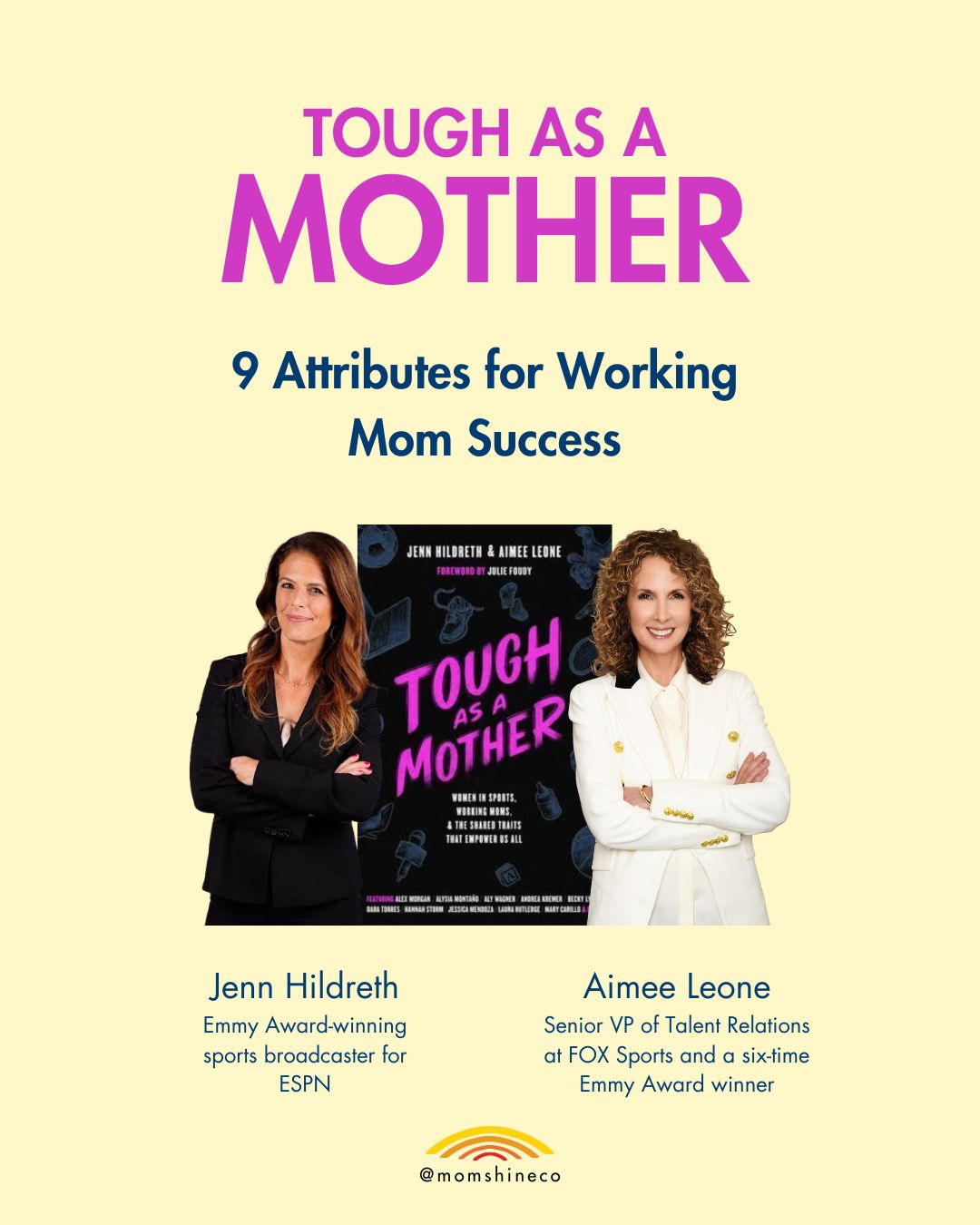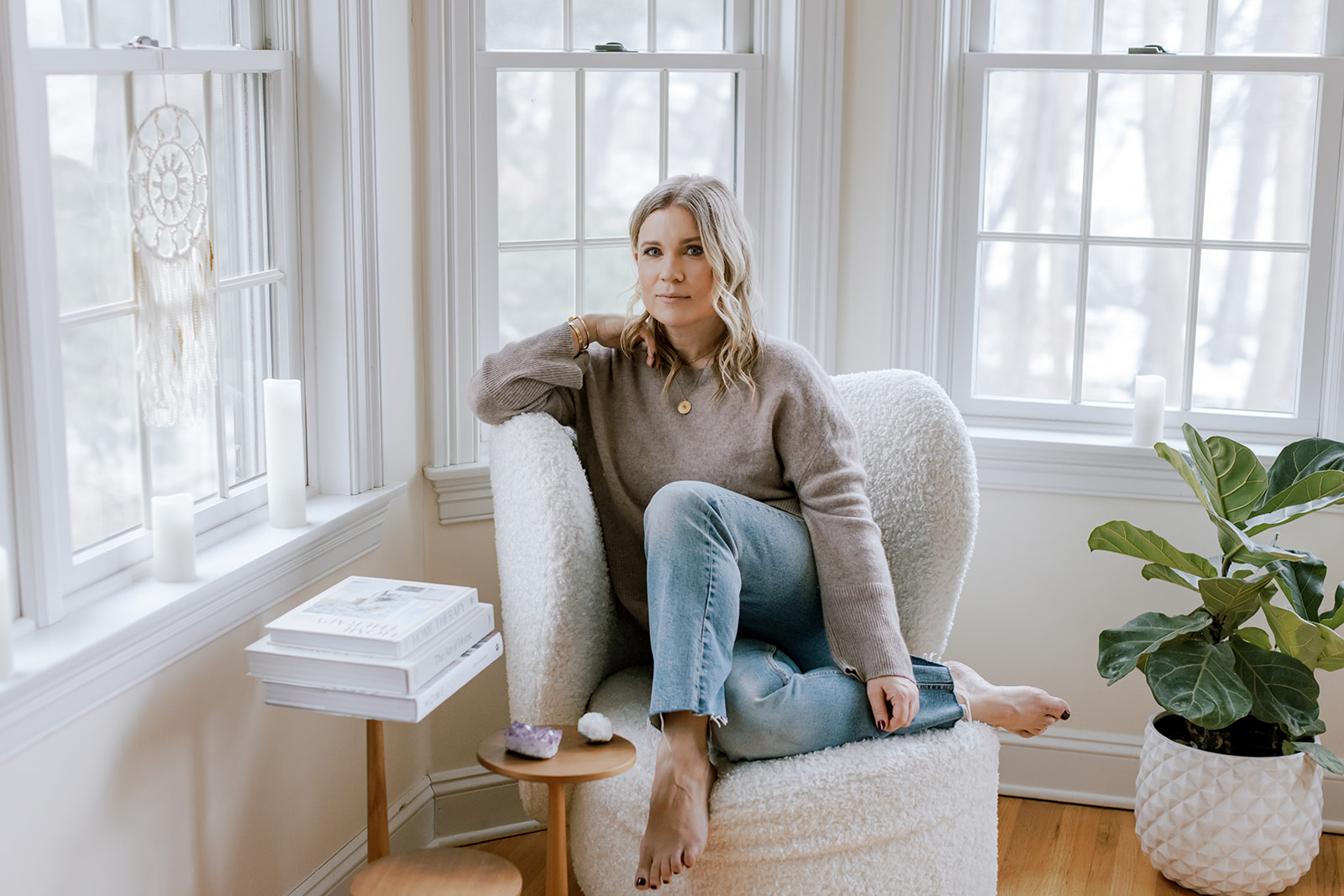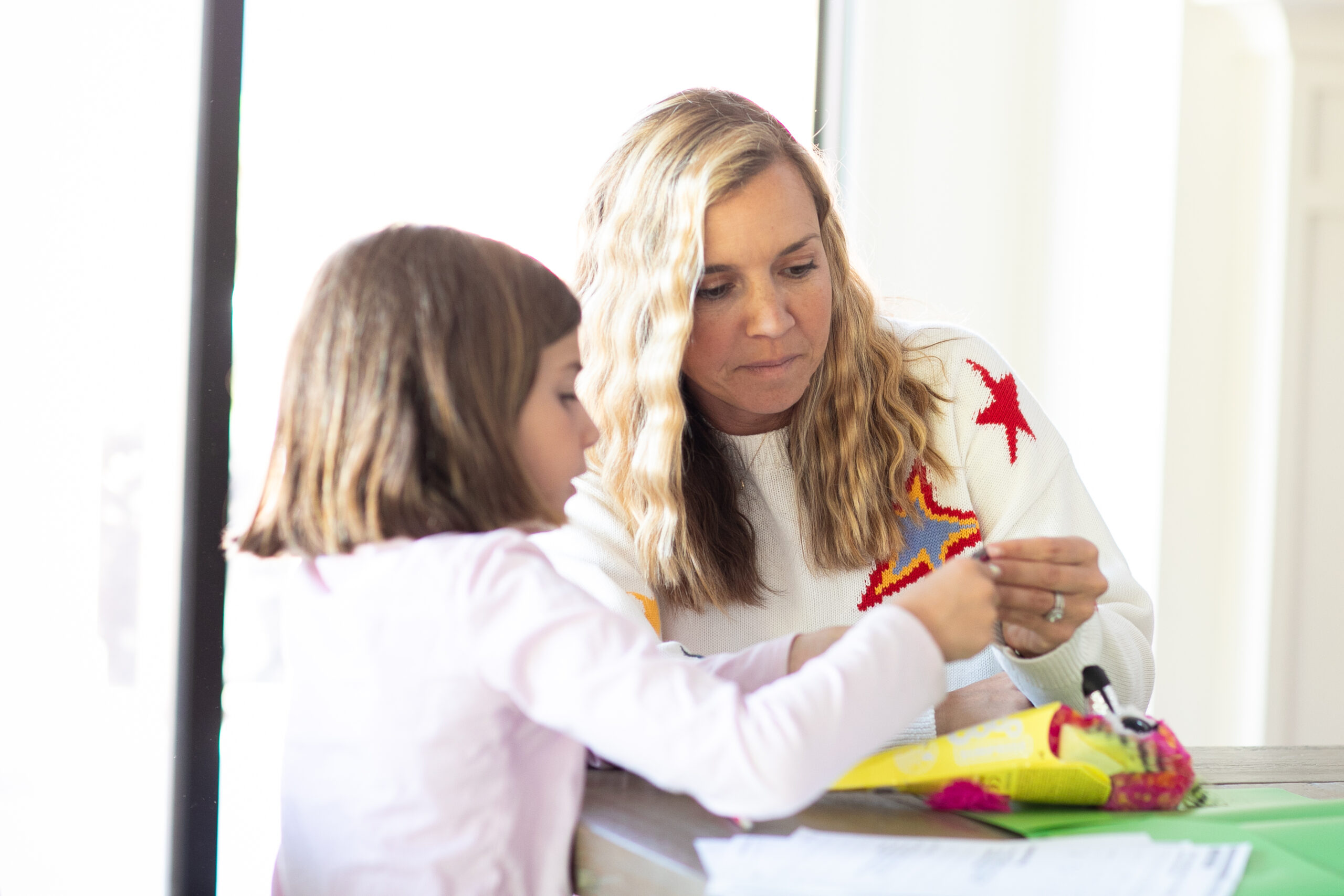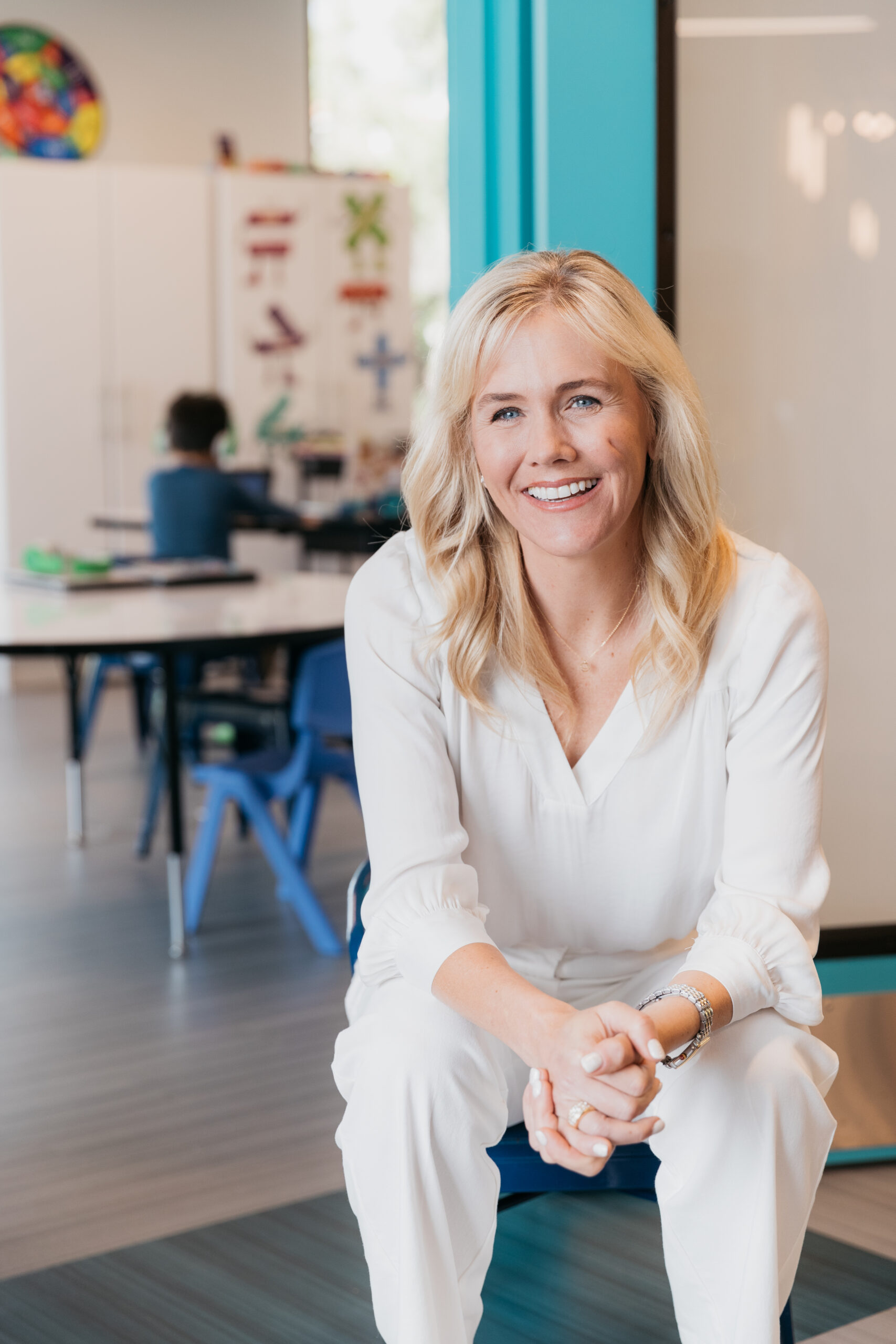Tough as a Mother: 9 Traits of Elite-Level Working Moms
When Emmy-winning broadcaster Jenn Hildreth and longtime Fox Sports exec Aimee Leone reached out about their new book Tough as a Mother, I instantly said yes. What I didn’t expect was just how deeply I’d relate to the stories inside—stories not just of athletic grit but of miscarriages, breastfeeding behind the scenes, cross-country travel with toddlers in tow, and building careers in male-dominated industries while raising tiny humans.
As a mom of three navigating my own career pivots and parenting curveballs, I found myself nodding (and tearing up) through nearly every chapter. These women aren’t just elite athletes and powerhouse professionals—they’re us. They’re every mom who’s juggled a conference call while wiping a nose, every woman who’s questioned if she can still go big after becoming a mom, and every parent who’s had to redefine what “balance” really means.
Below, I’m sharing 9 traits from Tough as a Mother that every working mom—whether you’re running a household, a team, or a business—can take to heart.
1. Adaptability — Hannah Storm
“We all make choices—sometimes they work out, sometimes they don’t, and we have to adjust. But this is the essence of what being a working mom is: always trying, changing the journey along the way, and at some point bringing your children along with you...”
—Hannah Storm, ESPN Anchor
Takeaway: Flexibility is your superpower. Plans change, kids get sick, jobs evolve—but your ability to pivot with purpose is what keeps your family (and career) moving forward.
2. Moxie — Debbie Antonelli
“My motto is: build, serve, empower. I use those three words to guide all of my decisions. I feel like I am the CEO of my own little company.”
—Debbie Antonelli, Basketball Hall of Fame Inductee
Takeaway: Channel your inner founder. Whether you're organizing the school week or leading a team, show up with grit and confidence. You’re not just managing a household—you’re running a high-performing operation.
3. Sacrifice — Cheyna Mathews
“Motherhood doesn’t change who you are. It doesn’t change what you are capable of. That person—all she is and all she can do—is just as important to your kids as it is to you.”
—Cheyna Mathews, FIFA World Cup Athlete
Takeaway: Sacrifice doesn’t mean erasure. Don’t lose yourself in giving. Instead, show your kids what it looks like to honor both your dreams and theirs.
4. Resilience — Hilary Phelps
“I used to compare my life to some of the people around me and I’d feel like a failure, but then I realized none of that stuff... mattered right now. We’re happy. That, to me, is the definition of having it all.”
—Hilary Phelps, Competitive Swimmer
Takeaway: Bounce back better. Real resilience is releasing unrealistic standards and defining success on your own terms. Being happy in the now is all you really need and a true power to embody.
5. Passion — Jessica Mendoza
“Everyone’s path is their own. I want to encourage women to write their own story. You know deep down what you want to do; you can love your job, be passionate about what you’re doing, and you are going to love the crap out of your children. Nothing is going to change that.”
—Jessica Mendoza, Olympic Medalist & ESPN Analyst
Takeaway: She got into it with a male colleague, asking her how she traveled so much. She said it’s no different if a man were to do so, too. Passion fuels perseverance. You don’t have to choose between your ambition and your children—your fire inspires them.
6. Vulnerability — Becky Lynch
“You’re constantly grappling with the guilt. It’s so different watching the male brain versus the female brain, too. My husband is wonderful—he’s the most incredible father and partner—but no part of him feels like he should give up his career to be a dad.”
—Rebecca Quin (aka Becky Lynch), WWE Superstar
Takeaway: It’s okay to feel it all. Acknowledging guilt, fear, or fatigue doesn’t make you weak—it makes you real. Vulnerability is how we connect, heal, and move forward.
7. Focus — Alex Morgan
“Because we can do it all, we try to do it all. Women apparently are supposed to get more sleep than men—but how are we supposed to do everything with our job, with our child, and at home while also getting more sleep? The math there is just not mathin’.”
—Alex Morgan, Soccer Legend
Takeaway: Focus means knowing what truly matters. Drop the “do it all” myth. Do what moves the needle—and let the rest wait.
8. Humility — Adia Barnes Coppa
“Sometimes my son, Matteo, would be running around like crazy, and I was just like, I just need a second to cry. Then I’d have to pick myself up, say, You got this. You’re good. And keep going.”
—Adia Barnes Coppa, NCAA Coach & Pac-10 Player of the Year
Takeaway: Humility is in the asking, the pausing, the honesty. You don’t need to be superhuman—you just need to keep showing up, one breath at a time.
9. Support — Julie Uhrman
“It’s about prioritization, dedication, commitment, passion, and presence. Finding a way to create a sense of harmony between work, life, and kids—versus balance. If you’re intentional with your actions, you can be great at both.”
—Julie Uhrman, Angel City FC Co-Founder & President
Takeaway: You don’t have to do this alone. Support isn’t weakness—it’s infrastructure. Build it, lean on it, and give it back.
Final Takeaways from Elite-Level Working Moms
If there's one thing these stories reinforced for me, it's this: support is everything, and passion is worth protecting. In other parts of the world, systems are built to support working moms. Here, we often have to build our own. But when you stay anchored in what lights you up, and surround yourself with people who get it, you don’t just survive—you rise.
So, which trait are you leaning into this week? Let us know by tagging @momshineco and @toughasamother_book, and share your favorite quote or takeaway from Tough as a Mother.
Listen to our full conversation, watch it on YouTube, and help us keep rewriting the rules of what motherhood looks like—and what moms are truly capable of.
Rome with Kids: 3 AI Travel Hacks for a Smoother Family Trip
Traveling to Rome with three kids in tow (ages 4, 9, and 12) has been magical, hilarious, and slightly chaotic in all the right ways. I wish I had found more honest family travel blogs before we arrived, because there’s so much you only learn on the ground. Like:
- Late June in Rome is sauna-level hot.
- You’ll want to pack only linen, breezy dresses, Birks or sneakers, and a solid backpack.
- Be prepared for jet lag, heat exhaustion, snack drama, and the kind of travel flexibility that can make or break a trip.
That said, if you keep expectations low and curiosity high, you'll ease right into la bella vita. Additionally, AI can save you if you're like us and enjoy planning on the fly. Here are three AI family travel hacks that saved my sanity during our trip, which you can apply to make the logistics much smoother.
1. Leverage AI to Navigate the Metros in Rome
One of the most rewarding (and sweaty) adventures we took. We climbed to the top of St. Peter’s Basilica—165 narrow steps each way—and even our 4-year-old made it most of the way up (with a little Hulk dad assist). The view is breathtaking and gives kids a real sense of accomplishment.
Pro parenting tip: Split up afterward if needed. I took the younger two home while my husband and our oldest ventured into the Sistine Chapel. There's no way the little legs would have made it.
AI Power Hack #1
Use ChatGPT or Google Maps with AI-generated route help to navigate the Rome metro system. I took the wrong train at first, then realized getting an Uber or taxi in Rome is basically impossible. AI helped reroute me on the fly.
2. Use AI to Maneuver What to Eat While You Travel
It’s crowded, and we are not ones to map out each and every day with three young kids. We like to maneuver on the fly, so for nights you eat in, you can input the local produce, and ChatGPT can come up with fantastic recipes to make. I'm also mostly gluten-free back home, and my AI tool knows that. It created a beautifully curated list of recipes and helped me make this fantastic frittata, which I survived on for the week.

AI Power Hack #2
Leverage AI to recommend what to make with local cuisine and where to go when eating out. If eating out for lunch, I highly recommend an incredible lunch at Bottega Ciccone, complete with amazing pizza and antipasti. If you’re planning to eat out for dinner, don’t miss dinner at Roma Sparita. Their cacio e pepe served in a parmesan bowl is what dreams are made of.
3. Ask AI for Easy Things to Do in Rome, Based on Your Kids Ages and Interests
Not far from Termini Station, the Santa Maria Maggiore, or one of the oldest churches in Rome, was one of the most peaceful and awe-inspiring spots we visited. The line moves fast, the ceilings dazzle, and it’s a great place to cool off—both literally and spiritually. Also, maybe confess those sins you’ve accumulated while bribing your kids with gelato.
Our kids lasted about 90 minutes at the Coliseum, which was perfect. We made it fun by staging pretend sword fights, imagining the crowds, and rewarding them afterward with gelato and granita. It’s an unforgettable place, but be sure to arrive early and book your tour time to avoid the heat and crowds.
Last but not least, I asked ChatGPT for the best kid activities to do on our last day there. Explora (a kids' museum) popped up and may have been one of my kids' favorite activities, along with a family bike and carriage through Villa Borguese beforehand. Explorea is a hands-on, kid-focused museum with water play, cooking, trains, and STEM zones—perfect for ages 3–12.
AI Power Hack #3
Ask AI if you are stuck on what to do if you get stuck. I input my kids' ages and interests, as well as our location, and it curated the perfect list to choose from.
How to Use AI to Discover Fun Family Things to Do in Rome
Traveling to Rome with kids isn’t always smooth, but it is always worth it. Let them sleep in, eat too much pasta, and explore at their own pace. When in doubt, slow down, split up, or bribe with gelato. And when your brain is too fried to figure out your next move, let AI help you shine.
AI is transforming parenting! For more inspiration, please check out my latest episode (Ep. 321) on how to save time and parent smarter, not harder, as we utilize AI to regain some precious time.
And if you would like the packing checklist or our full itinerary? Just let me know—I’m happy to share my lists from AI and how it helped me avoid any disasters during our time away!
10 Parenting Lessons Americans Can Learn from Sweden
Recently, I told a friend I was thinking about shifting back into a more full-time role. Her response surprised me: “But you’re so present with your kids.”
It hit me—why is that framed as an either/or? Can’t we be present and professional? Can’t we embody ambition and motherhood?
That tension is something I explored in a recent interview on my podcast with Emma Lundwall, a Swedish native and inspiring parent who shared how drastically different the parenting culture is in Sweden—and how much lighter it feels when there’s true systemic support behind working families.
She also pointed out a stat that stopped me in my tracks: The majority of mothers in Sweden work, well above the OECD average for maternal employment. Let that sink in. In fact, the country has a very large participation rate with nearly 90% of 25- to 64-year-olds employed on the Swedish labour market, according to statistics from the OECD. It’s not because they’re forced to—it’s because the ecosystem is designed to support them.
The parental leave entitles parents to 480 days of paid leave, divided equally between the two parents. From subsidized childcare to societal norms that value balance over burnout, Sweden is a living example that thriving as both a parent and a professional doesn’t have to feel impossible.
Here are 10 ways Swedish parenting differs from the U.S.—and why they matter more than ever:
1. Fostering Independence Early in Young Kids
Kids in Sweden walk to school alone (around age 4 and 5), are tasked to manage their time, and take responsibility from a young age. It’s about trust, and it’s modeled early and daily.
2. Prioritizing Outdoor Play
Rain or shine, children are expected to get outside. The national motto? “There’s no bad weather, only bad clothes.” And the kids? They’re better for it.
3. Minimal Overscheduling for Kids
There’s a cultural respect for downtime. Less chauffeuring to constant activities, more space for creativity, rest, and connection.
4. Gender Equality is the Norm in Parenting
Parental leave is not just available to mothers, and it is expected for both parents. This results in stronger co-parenting dynamics and a more shared mental load.
5. Avoiding Overpraising Your Children
Swedish parents celebrate effort, not just achievement. Resilience and persistence are core values over gold stars.
6. Play-Based Learning is Prioritized
Preschool isn’t about early academics—it’s about play, exploration, and curiosity. Learning is led by interest, not pressure.
7. Less Focus on Discipline, More on Dialogue
Instead of time-outs or punishments, Swedish parenting leans on conversation, empathy, and understanding.
8. Balanced Screen Time
Technology isn’t vilified—but it’s balanced with outdoor time, unstructured play, and shared experiences.
9. Encouraging Healthy Risk-Taking
Children are trusted with tools, allowed to climb trees, and encouraged to stretch their comfort zones safely.
10. Valuing Family Meal Time
Dinner is sacred. It’s not rushed or skipped. Families eat together, enjoy real food, and share their day, every day. A Harvard Study verified that 80% of teenagers open up with their families at the dinner table, and this has been shown to boost mental health for kids.
Final Thoughts: How to Change Your Parenting Mindset in the US
As I prepare for my next interview with elite athlete moms balancing Olympic training with school pickups, I can’t help but think: what if we could bring more of this balanced mindset home? What if we stopped glorifying the grind and started investing in support? What if our policies—and our parenting—reflected trust, balance, and respect?
The world doesn’t need more moms choosing between their ambition and their families. It needs more systems, stories, and shifts that allow us to fully shine in both. If this resonates with you, I’d love to hear in the comments. Check out my full episode with Emma up now on MomShine.
Skincare for Tweens: Your Guide to Clean & Confident Kids
The skincare aisle isn't just for grown-ups anymore. If you’re a parent to a tween or teen, chances are you’ve seen firsthand the explosion of youth-targeted clean skincare. From viral body sprays to bedtime routines packed with serums and creams, skincare is quickly becoming the self-care ritual for Gen Alpha.
In fact, in 2023 alone, tweens and young teens spent nearly $4.7 billion on beauty and skincare—and that number is only going up. But how much is too much? What’s truly safe for their growing bodies? And how do we make sure our kids are building confidence—not clogged pores?
On Episode 323 of the MomShine Podcast, I sat down with Sabrina Yavil, founder of Gryme, a clean personal care brand specifically designed for boys, to discuss raising skincare-smart kids—without the overwhelm or hormonal disruption.
Here’s what I learned—and what every parent should know.
Less Is More: What Kids Really Need for Healthy Skin
As tempting as it is to mirror adult routines, young skin has a natural barrier that doesn’t need layers of heavy creams, retinols, or scented serums. In fact, overloading skin at a young age can lead to early breakouts, barrier damage, or even hormonal imbalances.
Think of skincare like food: You wouldn’t feed your kids McDonald’s every day—so they don’t load up their faces with products designed for adult skin. Save the trendy actives and overnight masks for later in life. At this stage, your kids need:
- A gentle, hydrating cleanser
- A non-comedogenic moisturizer
- Mineral sunscreen (daily, even on cloudy days)
- Occasional exfoliation with parental guidance (tweens only)
Watch Out for “Greenwashed” Ingredients
Just because a product says “paraben-free” or “natural” doesn’t mean it’s safe. In our conversation, Sabrina reminded us that brands have learned how to label their products to seem clean—while still sneaking in:
- Synthetic fragrances
- Hormone-disrupting phthalates
- Harsh sulfates
- Dyes and preservatives banned in other countries
Pro Tip: Check which ingredients are listed first. If fragrance is one of the top ingredients, it might be better to pass. Additionally, consider European-produced products, as their skincare regulations are more stringent than those in the U.S. But always read the full ingredient list—and teach your kids how to do the same.
Why Boys Need Better Skincare, Too!
The skincare movement hasn’t traditionally included boys—but Gryme is changing that. Inspired by her own sons and backed by years of experience at Clinique and Bumble & Bumble, Sabrina built a line that’s clean, cool, and confidence-boosting.
Why this matters: It’s challenging to get teens to do the basics, such as showering. Boys often skip steps like applying lotion or conditioner so that a safe 2-in-1 product can be really helpful for an efficient bedtime transition. Giving them products that work—and aren’t secretly toxic—is a small but powerful way to support their mental and physical well-being.
Build Confidence, Not Consumerism
One of my biggest takeaways? Skincare is a teaching tool. Helping our kids discern what they put on their bodies teaches them to think critically about what they’re sold—whether on TikTok, in a store, or by their peers. This isn’t about policing their beauty hauls—it’s about modeling discernment. And that’s a life skill that shines well beyond the bathroom mirror.
Alicia’s Tween Self-care Picks for Summer
At our house, my son is obsessed with Gryme’s body wash and chapstick (especially with two older sisters around!). Here’s what I keep stocked:
- Gryme Hydrating Body Soap – Clean and gently scented
- Mineral Sunscreen – Brands like Thinkbaby, Blue Lizard, or Babo Botanicals
- BuzzPatch or Buggables bracelets for bug-free beach days
Want to try it? Use code MOMSHINE15 at Gryme.co for 15% off your purchase. Your summer toiletry bag just got safer.
Listen, Learn & Share
If this conversation resonated with you, make sure to:
- Listen to Episode 323: Raising Clean Kids: Skincare 101 & Confidence with Sabrina Yavil
- Rate and review MomShine on Apple or Spotify
- Watch the full interview on YouTube
- Share this post with a fellow mom navigating the beauty aisle minefield!
We’re all figuring this out together—and I hope this helps you breathe a little easier (and spritz a little less) on your next trip to Target.
Swedish Parenting Secrets: 5 Ways to Transform Your Family Life
What if parenting didn’t have to feel like a pressure cooker? What if fewer rules actually created more trust? What if independence came not from pushing—but from letting go?
After sitting down with parenting expert and globally-minded mama Emma Lundwall on the latest episode of MomShine, my entire perspective on parenting cracked wide open. Emma, who has raised her kids in both the U.S. and Sweden, shared how radically different Swedish parenting is—and how it’s working.
Turns out, they’re doing things very differently over there. And maybe, just maybe, we should be paying attention.
Here are five things I've learned about Swedish parenting—and how I’m starting to make some changes in my own life (and you can, too)!
1) Lead with Energy, Not Just Rules: The Swedish Parenting Approach
While this may be more Emma’s personal philosophy than a national Swedish norm, it aligns with the broader cultural emphasis on trust, connection, and dialogue over rigid discipline. In Sweden, kids don’t follow long lists of rules their parents lay out for them and are generally trusted early. Parents instead focus on how their energy impacts their parenting and leverage more communication, connection, and leading by example. That means your tone, presence, and overall vibe have more impact than your screen-time policies.
New habit I’m trying: Checking my own energy before I try to “correct” theirs.
2) Fostering Independence Early: Lessons from Swedish Kids
In both Sweden and Switzerland, fostering independence isn’t just a parenting choice—it’s a cultural expectation. Kids take public transport early (~starting in 1st grade), manage their own time, and are encouraged to explore. It’s all about confidence-building and preparing for real-life challenges. The culture is designed to encourage kids to take healthy risks, manage their time more responsibly, and have a system of support in place for their autonomy. Work schedules are designed around school hours, typically ending the day at 4 pm instead of 5 pm or later.
Shift I’m making: Trusting my kids with more small tasks. Packing their own bags, grabbing groceries with a list, and making their own breakfast.
3) Embrace the Outdoors: The Swedish 'No Bad Weather' Mentality
The Swedish have an expression: There is no bad weather, just bad clothes. Wouldn’t it be nice if schools didn’t close at the first sign of rain or cold? It’s not just about toughing it out—it’s about finding joy in nature, rain or shine. It’s a cultural norm that benefits both working parents and weather-proof kids. Things stay open to help working parents, and better yet, kids learn resilience, coming armed with raincoats, water shoes, and more, so they are prepared.
What I learned? Get them outside, no matter the cost. Stop complaining and grab a jacket instead!
4) Screen Time Wisdom: Swedish Parenting for Digital Natives
Emma doesn’t fight screen time—she approaches it with curiosity and connection. By removing the 'forbidden fruit' vibe, her kids are less obsessed and more aware of how screens impact their moods.
The goal with screen time? Tune in and entrust kids by coming with curiosity and fostering self-regulation. If you stop making it forbidden, kids stop obsessing over it. Screens are treated like tools—not trophies. And they need to be more empowered to learn boundaries instead of fearing screens instead.
My reframe: Ask why they want the screen before saying no. And notice what it’s telling me about how their day’s going.
5) Collective Parenting: Finding Freedom & Community Support
Emma reminded me that good parenting isn’t about perfection—it’s about presence. And sometimes, presence looks like a neighborhood food truck night where no one has to cook. Over 90% of moms work in Sweden. Why? Because the system is built for families—not against them. That includes real paid leave (480 days per kid, to be exact!), affordable childcare, and a culture of shared responsibility.
How I’m contributing: I hosted a free food truck night in my neighborhood, and it was a huge success! There was no cost other than each family buying what they needed, and our community was able to enjoy and connect. The food trucks were happy, too, on a mellow Monday! Because parents deserve a break—and a meal they didn’t have to make.
Final Thoughts: Swedish Parenting Mantras to Live By
We may not live in Sweden, but we can take inspiration from it. From how we show up with our kids to how we support one another, we can start shifting the system, one family at a time.
Want to hear the whole conversation with Emma?
🎧 Listen to Episode 322: Swedish Parenting—Ditching the Rules of the Old-Fashioned Way
Or catch it on YouTube!
Let me know on Instagram @momshine.co: What’s one Swedish-inspired parenting idea you’re excited to try?
Let’s keep shining,
Alicia ✨
5 Fun Things to Do in Orange County With the Family
As someone who grew up in Orange County and recently visited with my family, I can’t help but share some of my favorite things to do when we’re in town! We stayed in San Clemente — one of my favorite spots — because it’s so easy to get around, hit the beach, and enjoy great food without much fuss. Here’s a peek at our recent OC adventure and some recommendations for planning your own trip!
1. Hit the Beach
San Clemente’s T-Street Beach is our go-to. My husband surfs, and I sneak in a beach run that always fuels my soul. It’s a family-friendly spot, whether you’re riding waves or enjoying the sand. If you're looking for more kid-friendly learner waves, Doheny Beach and Dana Point area has much to offer, including lessons right there on the beach all summer long. I highly recommend Girl in the Curl as a great starting point.
2. Enjoy the Eats in OC
We’re big foodies, so we make sure to hit our favorites:
- Ichibiri in Dana Point is a fun, interactive dinner where they cook right before you (my kids love it!).
- Fisherman’s Restaurant on the San Clemente pier for an easy, casual lunch.
- Nomads — my all-time favorite healthy spot, perfect for a solo or friend catch-up.
- South of Nick’s — ideal for a much-needed moms’ night out!
- Harbor House is another hit for brunch if you want to please the whole family with a full meal to start the day.
3. Check the Local OC Hangouts
We joined friends for Friday night football games, which made us feel like locals again, and then we unwound poolside at the Ritz Carlton in Dana Point — a little slice of luxury. Salt Creek is an incredible beach that the whole family will love, complete with pop-up eating right there on the beach.
4. Shop the Best Spots
Local mom hack: Skip the tourist traps and head straight to San Clemente for that perfect blend of laid-back and family fun. Plus, who can resist outlet shopping?
- Nectarlife (moving from South Coast Plaza to Downtown Disney) — I’m obsessed with their all-natural whipped soaps. Bonus: use MomShine20 for 20% off! (Shop here)
- Lululemon Outlet at the San Clemente Outlets for great deals.
- Rainbow Sandals Outlet — a classic for picking up durable, beach-ready sandals.
5. Mark Your Calendar for Upcoming OC Events
Don’t miss the OC Fair or Wild Rivers Waterpark for summer visitors — both are guaranteed hits for the whole family.
Why We Go Back Every Year
This trip has become an annual tradition for us. Whether it’s surfing, shopping, or simply soaking in the SoCal sun, Orange County always delivers the perfect mix of relaxation and fun.
Top AI Hacks for Busy Moms: 6 Genius Ways to Simplify Life with Tina Sharkey
AI can feel overwhelming, but what if it gave you something you’ve been craving since becoming a mom?
…..Time.
On my MomShine podcast, I sat down with Tina Sharkey—a USC professor, early-stage investor, and lifelong innovator—to discuss how moms can actually use AI to lighten the load and be more present at home.
Spoiler Alert: Tina’s raising two sons, teaching the next generation how to lead with tech, and still managing to take screen breaks—thanks to a few smart AI audio agents.
She’s the former CEO of BabyCenter, a board member at PBS, an early advisor to The Skimm, and a professor of business innovation at USC. She also invests in early-stage companies through Magnify Ventures, focusing on the future of parenting and AI.
But first, consider these eye-opening statistics:
- The meal-planning app market hit $2.21 billion in 2024
- One AI-generated kids’ content channel racked up over 500 million views in a single month
- According to Education Week—62% of parents say they’ve heard little to nothing about how AI can be used in education
So, where do you start? Here are Tina’s favorite no-degree-required ways to let AI make your life easier:
1. Use AI to Plan Your Week Like a Pro
Think beyond spreadsheets. Tools like ChatGPT can take your kids’ sports, school, and screen-time rules—and help you build a calendar that works for everyone.
AI Mom Hack:
“Help me build a weekly calendar for a 12-year-old, 9-year-old, and toddler with school drop-offs, dinner at 6, and screen-free time from 4–6 p.m.”
2. What’s for Dinner? Let AI Figure It Out
No more staring at the fridge in a panic. Just type in what you’ve got, your time limit, and any dietary needs. AI will turn it into a recipe—and even suggest simple prep tasks for your kids.
AI Mom Hack:
“I have eggs, spinach, rice, and cheese. Create a 30-minute meal all three kids can help with—ages 4, 9, and 12.”
3. Travel & Packing Made Easy
Tina shared how AI helped her pack for a trip to Italy, down to carry-on limits, weather, and family activities. Say goodbye to overpacking and forgotten essentials.
AI Mom Hack:
“We’re going to Tahoe in spring with three kids. Create a packing list and meal plan for a 4-day trip.”
4. Create a Learning Coach (That Doesn’t Yell)
Need homework help? AI can act like a tutor, guiding your kids without giving away answers. You can also ask it to spark meaningful family conversations.
AI Mom Hack:
“Create a discussion guide for ‘To Kill a Mockingbird’ for a 12-year-old, focused on justice and equity.”
5. Go Screen-Free with Audio Agents
Welcome to Generation A or what could be called ‘Generation Audio.’ Tina uses voice assistants like Google Home or Siri to manage her schedule—no screen required. Less swiping, more presence.
AI Mom Hack:
Set up voice commands for calendar reminders, meal prompts, or weather updates—and keep your phone out of reach.
6. Teach Discernment with Deepfakes & Misinformation
AI isn’t all sunshine and meal plans. Tina reminds us that parenting can’t be outsourced. Use AI as a tool to teach kids critical thinking and discernment, especially for anything they see online.
AI Mom Hack:
Play “Truth or Trick?” at dinner. Show viral videos or images and ask your kids to guess what’s real—and why. Or just role-play. If the teacher said they were extending recess through the afternoon and the audio or video looked real, do you think that’s a real video or message? Have they done that previously, or does that raise suspicions?
Final Takeaway:
| “Use AI to outsource the planning—so you can focus on the doing.” Tina Sharkey |
You don’t have to be a tech expert. You just have to be curious. AI isn’t here to replace you, but it might just be here to help us shine and be more present in doing the things we love.
Listen to our latest episode for more parenting tips and how to use AI to simplify your life with our latest episode 321, Parent Smarter-Not Harder Using AI To Reclaim Precious Time!
.
Grieving a Family Pet: A Working Mom's Guide to Processing Loss with Children
There’s a certain kind of magic in the love of a dog.
Fifteen years ago, we brought Kona home—long before the chaos of kids, career changes, or the many joys and heartbreaks that life would bring. She was our first baby. She lived through the birth of all three of our children (now 12, 9, and 4), and somehow, she adapted with grace and quiet strength as our world evolved around her.
She wasn’t perfect—but she was perfect for us.
In our house, filled with energy, mismatched socks, and never-ending schedules, she was a calming presence. A soft landing. From the moment she greeted us each morning to her final days, she gave her all. Every single day.
And now… she’s gone. And the silence she left behind was louder than I ever expected.
A Dog Who Grew With Us
Kona hit her prime around 7, right around the time most dogs settle into themselves. It was like she matured with us. She took every adventure we threw at her, whether it was a move over the Golden Gate Bridge, a mountain hike, or a late-night snuggle session after another newborn feeding marathon.
She was there when I worked building my career at my first startup and was beloved by all my teammates as our unofficial marketing mascot. She sat with me through operations, miscarriages, the loss of my beloved grandmother, and some of the most vulnerable moments of my life. She celebrated every high and never wavered through any low.
She had a mischievous streak, too, that is worth mentioning:
- A stolen pink cupcake that gave her endless diarrhea? Worth it.
- A full chocolate advent calendar? Down the hatch—and out the other end.
- A bowl full of spilled popcorn stolen—oopsie.
- A poop on a Christmas present to mom? Sorry about that one.
And somehow, despite all her snacky adventures, she outlived her breed’s average lifespan by several years with minimal health issues.
A Dog Who Raised Our Kids, Too
Kona was there for all of it. She let my third wrestle her endlessly, unfazed by the toddler body slams she learned to endure from the first two. She let them climb on her, dress her up, and spill their secrets to her on hard days.
She taught them love.
She taught them patience.
She taught them presence.
Grieving Out Loud
Losing her has left a giant hole in our hearts and our home. We’ve never known a life without her. I counted. Five thousand three hundred days, in fact, we’ve only known a life with Kona in it. But I’m letting my kids grieve out loud. We talk about her. We cry. We laugh at the memories. We light a candle. We pray.
We remembered her in photos, videos, and appreciated the dozens of drop-offs, notes, and little gifts we’ve received from loved ones to work our way through it. And slowly, we’re learning to live with the loss.
How to Talk to Kids About the Loss of a Pet
Every child grieves differently, and depending on their age and development, their understanding of death can vary dramatically. Here’s what helped us and what experts recommend when helping kids cope with losing a beloved pet:
Ages 2–5: Keep it simple and honest.
Young kids often don’t understand the concept of permanence. Use clear, gentle language. Instead of saying, “Kona went to sleep,” which can be confusing or even scary, say, “Kona’s body stopped working, and she died. We won’t see her anymore, but we can always remember her.”
Offer comfort through routine and affection, and expect that they may ask the same questions again and again as they try to process what happened.
Ages 6–9: Encourage questions and allow emotion.
Children in this age group often begin to understand that death is final, but it may still feel confusing. Let them talk, cry, be angry, or even laugh. Encourage expression through drawing, storytelling, or creating a little memory box with their favorite photo or collar.
We let our kids light a candle and share their favorite Kona stories around the dinner table. It helped them feel heard and reminded them that it’s okay to feel big feelings.
Ages 10+: Let them lead the way.
Older kids may understand death more like adults do, but that doesn’t make it easier. They may want more privacy in their grief or feel pressure to stay “strong.” Make sure they know there’s no right way to mourn.
I told my oldest, “You don’t have to hold it together. Grief is love with nowhere to go.” That opened the door for a much-needed cry and some deep conversation that I’ll always remember.
What She Taught Me
In these quiet moments, I keep coming back to one truth: What matters most isn’t perfection—it’s presence.
Kona showed up. Every day.
She didn’t worry about the future. She didn’t dwell on the past.
She loved us completely, even in our mess.
She reminded us to greet each morning joyfully and give love freely. That, in itself, was the most profound kind of wisdom to leave with all of us.
For Anyone Else Grieving a Pet
If you’re grieving the loss of a beloved animal, know that you’re not alone. The pain is real because the love is real. What’s helped me:
- Letting it out. Cry, talk, share. Grief needs air.
- Honoring the memories. Light a candle, tell a story, and create a little tribute.
- Reflecting on the joy. They gave us so much more than we can ever give back.
Kona’s memory lives on in our home, in our hearts, and in every moment we choose presence over perfection. She wasn’t just a dog. She was our first family member. And she taught us how to love bigger, live fuller, and keep going—even after goodbye.
For more stories on parenting, love, and finding light in the mess, check out our new episodes on the MomShine podcast—the #1 show for busy moms working their way through the chaos.
Why Traditional Education Is Failing Our Kids—And What Parents Can Do About It
Education is one of the biggest concerns for parents today—and for good reason. Only 1 in 3 U.S. students are performing at grade level in math and reading, and despite massive spending, our schools rank among the lowest globally.
On this week’s MomShine podcast, I sat down with MacKenzie Price, the founder of 2-Hour Learning, to talk about why traditional education is failing our kids—and how parents can take action.
MacKenzie’s story is fascinating because she didn’t always love learning. In fact, she hated school growing up, even though she knew how to “play the game” and get A’s.
So when she saw her daughters losing their love for learning, she knew something had to change. Instead of trying to fix the broken system, she created an entirely new personalized learning model—one that’s revolutionizing education.
Why the Traditional School Model No Longer Works
Most schools still follow a one-size-fits-all approach, which means:
- Advanced learners get bored because they aren’t challenged.
- Struggling students fall behind because the curriculum moves too fast.
- Kids lose interest because they don’t get to explore their passions.
MacKenzie experienced this firsthand when her daughter became obsessed with the American Revolution. She went to her teacher, hoping to encourage her daughter’s interest, but the response was: "That’s not part of the curriculum, so we can’t spend time on it."
This moment hit her hard. Shouldn’t school be about nurturing curiosity instead of limiting it? That’s when MacKenzie knew it was time for a radical shift in our education model.
The Power of Personalized Learning
In traditional schools, learning isn’t one to one and is time-based, meaning that if a teacher moves on, the kids either keep up or get left behind.
MacKenzie’s model at her Alpha School does the opposite:
- AI-powered adaptive learning lets kids move at their own pace.
- There’s no unnecessary busywork—just targeted, effective lessons for each child.
- Kids finish academics in two hours and spend the rest of the day on real-world skills, group projects, and social-emotional learning.
The results? Her students are consistently outperforming our public schools in the top 1% nationwide.
How AI is Revolutionizing Education (Without Increasing Screen Time)
Many parents worry that AI in education means more screen time, but MacKenzie argues that she’s actually seeing the opposite in her learning model. Instead, she’s seeing:
- AI eliminates wasted time on unnecessary worksheets and test prep.
- Personalized lessons so kids stay engaged.
- Teachers focus on a key part of learning that’s getting missed today—emotional and motivational support instead of just grading and lecturing.
The best part? Her AI can track a child’s progress in real time, so instead of waiting for a test score to tell you they’re struggling, learning gaps get addressed immediately. Imagine if your child’s math app could tell you exactly which concepts they needed help with and adjust lessons accordingly. That’s the real power we can harness from AI in education.
The Future of Schools: What Education Could Look Like in 10 Years?
If AI-powered personalized learning became the norm, education could look radically different. Students would master concepts faster because they learn at their own pace. There would be no “one-size-fits-all” teaching, and schools would instead prioritize real-world skills, like creativity, problem-solving, and collaboration.
Did you know that 60% of college graduates are unprepared for the workforce, with 40% of employers admitting they intentionally avoided hiring Gen-Z college grads? Currently, traditional models are failing to prepare kids for the real world if we keep AI out of the curriculum. Instead, MacKenzie’s 2-Hour Learning model is proving there is another way that gets kids more time for real-world learning, and she’s opening 25 new schools nationwide in the coming year.
What Parents Can Do Today to Support Their Kids’ Education
Unfortunately, many areas across the US are still tied to traditional models, but it’s a big conversation at the moment, and with the current administration that’s advocating for states to take these decisions into their own hands. But there are easy ways, MacKenzie offered, to get started until our education can catch up.
- Use AI at home and to help with kids’ assignments—Try ChatGPT for homework help or create personalized “choose your own adventure” reading stories. OR simply type in problems so students can get exposed to easy ways to cross-check their own work with you.
- Leverage good apps that gamify learning for kids—My daughter loves Prodigy, and I just upgraded the subscription so she can build out her animal pet store through crushing her math facts. She also jumped up in her testing scores as a result.
- Ask teachers and schools for transparency. Find out if your child’s school does MAP testing and request the full report, not just a snippet, which MacKenzie says most parents get instead of the full picture.
- Advocate for change locally—Visit futureofeducation.net for free toolkits to improve your community's learning options.
- Explore new education models you can apply at home—Check out 2-Hour Learning for AI-powered homeschooling or in-person school options.
Listen to the Full Interview
This conversation completely changed my perspective on education, and I know it will for you, too. My mom worked in public education for over 47 years, as well. I find it exciting and fascinating because of the potential change that might be ahead. More importantly, I learned how to approach AI with curiosity with my own kids to keep them in the know and thriving at learning.
If you’d like to check out my interview with MacKenzie Price, you can find it on Apple, Spotify, or wherever you get your podcasts. You can also watch us talk through these issues live on YouTube.
Let’s start demanding better education for our kids. At an overarching level, it hasn’t changed in over 100 years in a way that supports kids' growth and learning for our modern world. We would love to hear your thoughts—do you feel like traditional education is failing our kids? Tag us on Instagram @momshineco to continue this important conversation.
Giada De Laurentiis's Super Italian: Essential Cooking Secrets Revealed
Last week, I had the chance to attend Giada De Laurentiis’s Super Italian book event at Book Passage in Corte Madera. There, she was interviewed by Liz Moody, the #1 wellness podcaster and author of 100 Ways to Change Your Life.
It was an evening filled with insider cooking tips, Italian lifestyle wisdom, and a refreshing perspective on slowing down and embracing La Dolce Vita—because, as Giada says, "Italian life is about savoring, not rushing."
Here’s what I took away from this intimate and inspiring conversation:
Live La Dolce Vita—Slow Down, Savor More
For Giada, living La Dolce Vita isn’t just about food—it’s about intention. Slowing down, taking in your surroundings, and focusing on quality over quantity.
And that philosophy extends to cooking, too. Simplicity is key. Giada swears by high-quality ingredients that don’t need much fuss. Slowing down in the kitchen is also essential. Cooking isn’t just about the end result—it’s about enjoying the process.
Giada’s Game-Changing Cooking Tips
I loved hearing firsthand from Giada about her passion behind writing her 11th book, Super Italian. She says that each book represents a phase in her life and journey. This one in particular comes after a phase of not feeling her best. She suffered from debilitating sinus infections and gut problems. She wanted a book that wasn’t only about how to keep enjoying food but also about how food can support you in feeling your best in the process! Some of what’s included:
- Make Bread Crumbs, but Also Make Them Flavor-Packed: Her garlicky anchovy breadcrumbs can elevate any dish—sprinkle them on pasta, salads, or even grilled veggies.
- The Magic of Sicilian Pesto: There’s a whole section in her book dedicated to condiments because, according to Giada, great food is all about layers of flavor. Her Sicilian pesto is a must-try, and it’s also like eating a mini-salad as Liz put it.
- The Truth About Pasta: Did you know that true Italian pasta should only have two ingredients? Pastas should only have durum wheat semolina and water. That’s it! Many mass-produced pastas in the U.S. are pushed through plastic molds and filled with gums and additives, which she avoids.
In the Q&A portion of the night, she also covered some of her go-to pasta brands:
- Giadzy Pasta: Her line of artisan, bronze-die cut pasta that's imported from Italy.
- Jovial Foods: A solid option sold at Whole Foods, especially for kids.
A food pro tip for her natural glow? Olive oil. Giada consumes about ¼ cup of olive oil a day in her meals. She also closes out a good day with her go-to DIY face scrub. It’s a mix of rice flour + olive oil for that natural, dewy glow.
Behind the Scenes: Giada’s 7 Tips on Food, Travel & Life
The best part of going to a book event with the author is that you get secrets that sometimes aren’t included in the book, but give more context to the choices of what is included. Here are some of my favorite behind the scenes tips from a night with Giada at my local books store.
Tip #1: Take Risks. Before taking a leap in starting her career on The Food Network, which launched her into food star-dom, she thought: What did I have to lose? When she first got into television, she had to take a leap of faith—seeing it as an opportunity to go for it without fear of failure. Her family wasn’t sure it’d even work out, so why should she?
Tip #2: Failures Make You Better. She believes every misstep leads to growth—whether it’s in the kitchen or in life.
Tip #3: Dry Pasta, Not Fresh Pasta, 9 times out of 10. Surprisingly, she chooses dry pasta over fresh most of the time, just like in Italy—except in Bologna, where fresh pasta reigns supreme.
Tip #4: The Best Italian Breakfast—A Cornetto. Forget eggs and bacon—the most authentic way to start your day in Italy? A cappuccino & a “Cornetto” (Italy’s version of a croissant—light, flaky, and slightly sweet!).
Tip #5: Cocktail over Vino. She prefers a straight-up tequila with fresh orange over wine any day. Shocker!
Tip #6: Dream Vacation—On a Boat! Santorini & Escia—because, as she puts it, "There’s nothing better than sleeping on a boat."
Tip #7: She Has One Go-To Italian Restaurant Recommendation. She said most people love Dal Bolognese if you’re ever near the city center in Rome. Kids or no kids in tow—it’s always a hit.
Giada’s Best Cooking Tips (AKA: Why You’ll Want to Buy This Book!)
Most importantly, I learned my “Garlic Rule of the Year” at this event! Not included in the book, but makes you realize how real chefs know the best kept secrets. Her tip? Remove garlic once it turns golden brown in olive oil. Otherwise, it’ll overpower the dish and alter the flavor.
I also can’t wait to try some of her favorite dishes she talked about that are included in her new book:
- Garlicky Bread Crumbs—to add flavor and texture to any meal (page 47)
- Layerless Sheet-Pan Lasagna (page 135)
- Filet Mignon with Gorgonzola and Balsamic (page 174)
- The Ultimate Easter Dessert? Her Orange Olive Oil Cake (page 257)
I also loved to hear her most ordered dish at her restaurants……Lemon Spaghetti. Every. Single. Time.
Her Final Words of Advice?
In the final Q&A fire round, she shared some tips that really blew my mind.
- Cooking on a boat? Use ½ ocean water & ½ filtered water for pasta.
- Her go-to meal when her family gets together? Breaded veal with broccoli rabe.
- Her favorite spice level? Minimal. She doesn’t love too much heat in food as it takes away from the flavor.
- Best pantry staple? Dried fruit—it’s always a great snack for adults and kids.
Final Thoughts
Giada’s event wasn’t just about food—it was about a way of living. A reminder to slow down, savor the moment, and embrace simple pleasures. Her new book isn’t just a cookbook—it’s an invitation to live, cook, and eat like an Italian. And after hearing her talk, I think we could all use a little more La Dolce Vita in our lives.
Want to bring more ease and joy into your everyday life? Grab a cup of coffee (or a cocktail, if you’re channeling Giada) and tune into the latest on the MomShine Podcast—where we dive into real mom talk, slowing it down and simplifying the many conundrums that come up in mom life.










